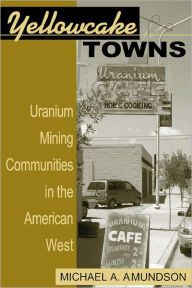Uranium was discovered in southwestern Colorado in the late nineteenth century. It comes from carnotite ore, which also produces vanadium. When these elements were first mined, vanadium was considered to be the more valuable of the two; it was used as an alloy to strengthen steel. In 1921 the Colorado Geological Survey issued Radium, Uranium, and Vanadium Deposits of Southwestern Colorado, an excellent resource for understanding the early development of the industry prior to the nuclear age.
 By the mid-twentieth century, during WWII and especially during the Cold War, uranium was highly sought after by the military for its use in the development of nuclear weapons. Most of Colorado’s uranium extraction took place in what is known as the Uravan Mineral Belt, located primarily in Montrose and San Miguel counties. Uranium extraction produced a yellowish substance resembling a cake mix, so the mill towns that developed were nicknamed “yellowcake towns.” (Check out from our library the book Yellowcake Towns: Uranium Mining Communities in the American West, published by University Press of Colorado, for more information). Examples of yellowcake towns in Colorado included Naturita, Nucla, Paradox, Slick Rock, and Uravan. Uranium has also been mined in other parts of the state as well.
By the mid-twentieth century, during WWII and especially during the Cold War, uranium was highly sought after by the military for its use in the development of nuclear weapons. Most of Colorado’s uranium extraction took place in what is known as the Uravan Mineral Belt, located primarily in Montrose and San Miguel counties. Uranium extraction produced a yellowish substance resembling a cake mix, so the mill towns that developed were nicknamed “yellowcake towns.” (Check out from our library the book Yellowcake Towns: Uranium Mining Communities in the American West, published by University Press of Colorado, for more information). Examples of yellowcake towns in Colorado included Naturita, Nucla, Paradox, Slick Rock, and Uravan. Uranium has also been mined in other parts of the state as well.
Uranium mining became one of Colorado’s major industries in the Cold War era; according to the Colorado Encyclopedia, 63 million pounds of uranium were produced in the Uravan Mineral Belt between 1948 and 1978.
Eventually, the decades of radium, uranium, and vanadium extraction began taking a toll on the environment. In 1971 the State published Uranium Wastes and Colorado’s Environment, which exposed many of the problems caused by uranium mining. Colorado’s Involvement with Uranium Mill Tailings, published in 1976, also explored this issue. Both reports are available online via our library.
The impact on public health was also a growing concern. A linkage between uranium mining and the development of cancer in mine workers became apparent, and in 1990 Congress passed the Radiation Exposure Compensation Act. These health concerns, alongside new environmental regulations and the availability of cheaper uranium from other countries, caused Colorado’s uranium industry to bust. By the early 2000s, however, development of new radioactive waste disposal facilities caused a resurgence in interest in uranium. (See Uranium, It’s Hot!! And Back by Popular Demand, part of the Colorado Geological Survey’s Rock Talk series.)
Further resources on uranium available from our library include:
- Baseline Radiological Investigation Report in Support of the Application for a License for Source Material Milling Piñon Ridge Uranium Mill, Montrose County, Colorado (Colorado Department of Public Health and Environment, 2009)
- Colorado Water Quality Standards and In-Situ Uranium Recovery (Colorado Department of Public Health and Environment, 2007)
- Decision Analysis and Environmental Impact Analysis, Energy Fuels, Piñon Ridge Uranium Mill (Colorado Department of Public Health and Environment, 2011).
- The Extractive Metallurgy of Uranium (Colorado School of Mines, 1971). Available for checkout in print.
- Hydrogeologic and Stratigraphic Data Pertinent to Uranium Mining, Cheyenne Basin, Colorado (Colorado Geological Survey, 1980).
- Map of Colorado Uranium and Vanadium Mining and Milling Activities (Colorado Geological Survey, 1978).
- Nuclear Power and Uranium Fuel: Requirements in the Western United States (Western Interstate Nuclear Board, 1975).
- Policy Recommendations on Financing Stabilization, Perpetual Surveillance and Maintenance of Uranium Mill Tailings (Western Interstate Nuclear Board, 1977).
- Promises and Problems of a New Uranium Mining Method: In Situ Solution Mining (Colorado Geological Survey, 1979).
- Uranium Geology and Exploration (Colorado School of Mines, 1978). Available for checkout in print.
- Uranium Mill Tailings Management Annual Report (Colorado Department of Public Health and Environment, 2000-2015).
- Uranium Mining in Colorado 2012 (Colorado Division of Reclamation, Mining and Safety, 2012.
- How to Spot the Differences Between Eagles and Hawks - August 16, 2021
- How Transportation Projects Help Tell the Story of Colorado’s Past - August 9, 2021
- Time Machine Tuesday: The Night the Castlewood Canyon Dam Gave Way - August 3, 2021